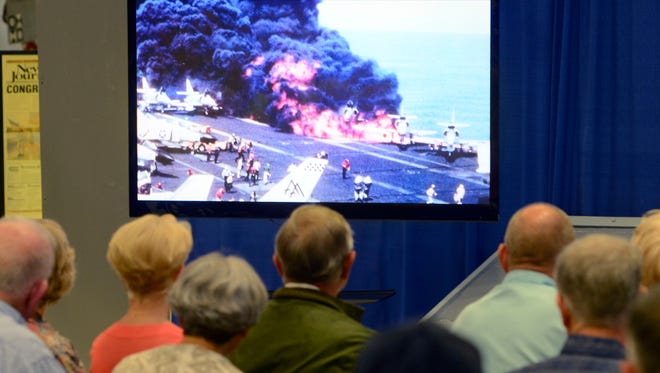Heroism recalled 50 years after deadly fire aboard USS Forrestal

PENSACOLA, Fla. — To this day, retired Navy Capt. Flack Logan carries a flashlight with him.
He's seen day turn to night in an explosive instant and watched clear skies swallowed by blanket-upon-blanket of smoke and fire.
And when he descended down into the aircraft carrier USS Forrestal in the immediate aftermath of a fire that killed 134 men 50 years ago, there was no darker sight. He and others were there to move the dead and place their charred remains into body bags.
"It was, ...'' Logan halted a bit as he remembered the sight of his shipmates' bodies in the dark. "It was terrible."
Logan and retired Rear Adm. Peter Booth, both survivors of the Forrestal fire on July 29, 1967, in the Gulf of Tonkin during the Vietnam War, recounted events of the tragedy on Saturday at the National Naval Aviation Museum in Pensacola.
Read more:
Sen. John McCain barely escaped death 50 years ago in the USS Forrestal disaster
USS Forrestal survivor looks back, 50 years later
Experience life on the USS Eisenhower
"We were given masks and gloves and took the bodies out in bags and gave them to the corpsmen."
But it was so dark, and the bodies were so damaged, that mistakes were made. At one point, Booth and a colleague had accidentally put two corpses in one bag.
"It was a difficult thing to do."
The inferno started before 11 a.m. when a Zuni rocket was accidentally launched from an aircraft because of a short-circuit, racing across the flight deck and hitting the fuel tank of an A-4 Skyhawk. Heated by the fire, another bomb exploded, ripping a hole in the flight deck and spraying the deck and crew with burning fuel and shrapnel. In all, 10 bombs exploded.
Logan was on the flight deck when the first explosion occurred.
"I thought, 'Did that come off my plane?' " Logan told the crowd. Soon, he was working with other pilots to rescue the wounded and those still in harm's way.
Booth, who a decade later would become commanding officer of the Forrestal, was in his squadron's ready room when the first explosion occurred. He scrambled to help however he could, but only the ship's firefighters were trained in fire-fighting techniques and there was a shortage of hoses.
He said every man did what they could to help combat the unfolding tragedy.
Also on the deck that day was future Arizona Republican Sen. John McCain, then a 30-year-old lieutenant commander. McCain was in the cockpit of his Skyhawk, getting ready to take off.
The Navy's post-fire investigation apparently concluded that the malfunctioning missile hit the plane to his right, according to 2008 research by the website FactCheck.org.
McCain exited the cockpit. His flight suit caught fire as he jumped through the flames, according to his first-person accounts.
"The crew's heroics kept her afloat," McCain recalled in Faith of My Fathers, his memoir published as he was gearing up to run for president in 2000. "They fought the inferno with a tenacity usually reserved for hand-to-hand combat. They fought it all day and well into the next, and they saved the Forrestal."
Booth said that commitment to mission, each other, the Navy and country still rings true today.
"And so, as it was then, so to it is today,'' Booth said. "Young men and women doing their bit in the service of their country, far out on nameless oceans and deep in the sunless interiors of U.S. Navy ships doing the tough job 24/7. Just as (Saturday's) remembrance will help us perpetuate the deeds of those no longer with us, so too is it a reminder of what heroism, service and sacrifice are all about."

Contributing: Dan Nowicki, The Arizona Republic